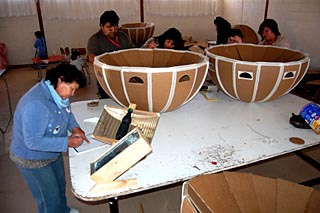(→Articles in the media: Link to Villaseca article in La Nacion) |
m (Video -> file swapover) |
||
| (46 intermediate revisions by 6 users not shown) | |||
| Line 1: | Line 1: | ||
| − | {{GoogleTranslateLinks}} |
+ | {{GoogleTranslateLinks}} |
| + | |||
| + | {{Updated|8|27|14}} |
||
| + | ==Events== |
||
| + | {{CalendarAndPastEvents}} |
||
| + | =={{FeaturedProjectTitle}}== |
||
| + | [[File:Villaseca Solar Restaurant 11-10.jpg|thumb|300px|The [[Delicias del Sol]] restaurant in Villaseca, Chile]] |
||
| + | *'''Solar restaurant in Chile has produced profits''' - The [[Delicias del Sol]] restaurant, known for serving excellent food, has become a tourist destination for the village of Villaseca, Chile. Begun in 2000 with an initial seating capacity of sixteen, the solar restaurant now seats 120. The dry central valley area receives over 300 days of sunshine a year, and like similar areas, traditional fuel sources are becoming ever more scarce and expensive. The tourists enjoy viewing the solar kitchen at work. [[Villaseca Solar Restaurant|Visit the Delicias del Sol restaurant.]] |
||
| + | |||
| + | {{SignificantProjectLink}} |
||
| + | |||
==News and Recent Developments== |
==News and Recent Developments== |
||
| + | [[File:Early solar cooking in Chile, Pedro Serrano, 8-27-14.jpg|thumb|300px|Solar cookers being developed in 1989 in Chile. - ''[[Pedro Serrano]]'']] |
||
| ⚫ | *'''August 2009:''' Responding to the urgent need to introduce alternative fuels, the United Nations Development Program, the Global Environment Facility and the European Union partnered with the Chilean government and communities in northern Chile to bring an eco-friendly and creative solution – using energy from the sun. |
||
| + | *'''August 2014:''' [[Pedro Serrano]], a longtime advocate for environmental conservation and justice, has just released the first installment of the technical, social, and political issues contributing to the history of solar cooking in Chile. Read the report: [http://www.ises-online.de/fileadmin/user_upload/PDF/ISES_Webinar_SolarCookers_P._Serrano.pdf Solar Cookers in Chile: Technical, Political and Socio-cultural Issues] - ''[[Pedro Serrano]]'' |
||
| + | [[File:Chile box cookers 2, Guai Bao, 1-14-14.jpg|thumb|300px|Recently constructed [[solar box cooker]]s in Ovalle, Chile.]] |
||
| + | *'''January 2014: New solar cookers ready for distribution in Chile''' - Guai Bao, traveling in [[Chile]], sent along this photo of newly constructed [[solar box cooker]]s at a manufacturing facility in Ovalle. The cookers are well thought out. They are sturdy with insulated inner walls, and an internal high-back reflector to catch late day sun. The front wall is low and slightly tipped forward to avoid blocking any sunlight. The external side reflectors appear to be able swing closed and protect the glass surface. They look ready to start cooking sitting on the small tables, which provides a convenient work height for users. The cooker construction is being supervised by [[Ruddy Viscarra]]. See more [https://www.facebook.com/media/set/?set=oa.10152103262019407&type=1 assembly photos] on [https://www.facebook.com/groups/scwnet facebook]. |
||
| + | |||
| + | [[File:Technical University Federico Santa Maria, Ruivo, 10-19-13.jpg|thumb|300px|Technical University Federico Santa Maria students with [[Celestino Ruivo]] and [[Pedro Serrano]]]] |
||
| + | *'''October 2013:''' [[Celestino Ruivo]], Doctor of the University of Coimbra 's academic and University of Algarve, [[Portugal]], visited the Technical University Federico Santa Maria invited by the Academic Department of Architecture, [[Pedro Serrano]]. Both belong to international solar cooking organizations. Dr. Ruvio has been developing new lightweight and portable solar cookers, and spent time with students to discuss innovation. Later they traveled to Villaseca to visit [[Delicias del Sol]], the popular local solar restaurant. [http://www.dgc.usm.cl/2013/10/04/realizan-experiencias-con-cocinas-solares-en-la-universidad-santa-maria/ More information...] (Spanish) |
||
| + | |||
| + | [[File:Carlos patricio Eyquem solar oven Chile, 3-19-13.jpg|thumb|300px|Carlos patricio Eyquem (on right), with his partner Javier, won first place in Chile's national competition for solar oven design.]] |
||
| + | *'''March 2013: Solar oven design contest winners''' - Carlos patricio Eyquem, with his partner Javier, won first place in Chile's national competition for solar oven design. Their [[solar box cooker]] design also incorporates some convective and conductive heat transfer concepts. There is a small array of oil-filled copper tubing in front of the cooker which becomes hot, and through convection, transfers the heat to the bottom of the cooking pot inside the cooking chamber. The copper tubing becomes hot as well, and transfers additional heat to the cook pot through direct conduction. Carlos has included some instructions on how to make their design. [http://www.urgentevoke.com/profiles/blogs/solar-oven Read more...] |
||
| + | |||
| + | *'''December 2012:''' The [[Delicias del Sol]] restaurant, known for serving excellent food, has become a tourist destination for the village of Villaseca, [[Chile]]. Begun in 2000 with an initial seating capacity of sixteen, the solar restaurant now seats 120. The dry central valley area receives over 300 days of sunshine a year, and like similar areas, traditional fuel sources are becoming ever more scarce and expensive. The tourists enjoy viewing the solar kitchen at work. [http://ntdtv.org/en/news/world/asia/2012-12-10/chilean-solar-oven-restaurant-shines.html Read more...] [[File:Restaurant's Ovens Powered by the Sun|thumb|right|400px|The [[Delicias del Sol]] restaurant has become a tourist destination for the village of Villaseca, [[Chile]] in 2012.]] |
||
| + | *'''October 2011:''' The borough of Combarbalá, located in northern Chile, is soon to be named Chile’s first “solar neighborhood”. The households will use solar panels to heat 16 gallons of water at 113 °F, which will allow savings up to 80 percent on the Chile’s notoriously high gas bills. To take advantage of the system, each house was built with an orientation towards the north to get the most sunlight possible. In addition, families were trained in energy saving and solar cooking and heating. [http://www.santiagotimes.cl/chile/science-technology/22689-chiles-first-solar-neighborhood-to-debut-next-week Read more...] |
||
| + | *'''April 2011:''' Restaurant Ayllu in San Pedro de Atacama has begun using solar cookers to prepare food for their patrons. Guests are welcome to see the solar cookers in action. Watch a [http://www.youtube.com/watch?v=qJ6JgqYd1yE video] of a recent afternoon's activity. |
||
| ⚫ | *'''August 2009:''' Responding to the urgent need to introduce alternative fuels, the United Nations Development Program, the Global Environment Facility and the European Union partnered with the Chilean government and communities in northern Chile to bring an eco-friendly and creative solution – using energy from the sun. The project sparked entrepreneurship, and some apprentices have become masters, selling ovens, stoves or teaching the techniques to other communities in other regions. In a previous, similar initiative in Chile’s Atacama Desert, local people built special stoves that look like mirrored parabolic dish antennas. Miguel Perez, one of the beneficiaries, now teaches the solar stove-building techniques to people in neighbouring communities. Click [http://content.undp.org/go/newsroom/2009/june/world-environment-day/los-hornos-solares-ayudan-a-chile-a-prevenir-la-deforestacin.en?g11n.enc=ISO-8859-1 here] for the full story. |
||
[[File:Chile neighbors1.jpg|right]] |
[[File:Chile neighbors1.jpg|right]] |
||
| Line 8: | Line 32: | ||
==The History of Solar Cooking in Chile== |
==The History of Solar Cooking in Chile== |
||
| ⚫ | The long thin nation of Chile, stretching along the western flank of the Andes for close to half of the continent, has lively and extensive solar cooking programs in this part of the world. Considerable collaboration between a number of university faculty members, government units, and voluntary organizations has produced a situation which provided enormous publicity for the use of solar cookers. Even though the technology cannot be used in all parts of Chile for all months of the year, a number of projects have been carried out successfully and use is widespread in areas where solar cooking is appropriate. |
||
| − | The long thin nation of Chile, stretching along the western flank of the Andes for |
||
| ⚫ | close to half of the continent, has lively and extensive solar cooking programs in this part of the world. Considerable collaboration between a number of university faculty members, government units, and voluntary organizations has produced a situation which provided enormous publicity for the use of solar cookers. Even though the technology cannot be used in all parts of Chile for all months of the year, a number of projects have been carried out successfully and use is widespread in areas where solar cooking is appropriate. |
||
Faculty members of the Institute of Nutrition and Food Technology, University of |
Faculty members of the Institute of Nutrition and Food Technology, University of |
||
| Line 15: | Line 38: | ||
excellent solar cookbook for use in projects in Spanish-speaking countries. |
excellent solar cookbook for use in projects in Spanish-speaking countries. |
||
| ⚫ | A number of other institutions have collaborated in solar promotion in Chile, including the Universidad Technica, School of Architecture, where a prominent promoter, [[Pedro Serrano]], is affiliated. The best known project in Chile is located in [[Villaseca]], also north of Santiago. In this community, virtually all residents cook with solar power. The area is ideally suited, being blessed with 310 days of sunshine in a year and plagued by dramatic fuel scarcity. Perhaps the best known part of the work in [[Villaseca]] (and certainly the best publicized) is the open-air solar restaurant using ten large reflecting ovens and providing employment for members of 26 families. It serves meals to around 60 people a day and must turn down 40 others until it can increase its capacity. It is a frequent stop for tourist groups from many nations. The owners also use homegrown organic vegetables and fruits and are reputed to serve the best food in Chile. |
||
| − | A number of other institutions have collaborated in solar promotion in Chile, |
||
| − | including the Universidad Technica, School of Architecture, where a prominent |
||
| ⚫ | promoter, [[Pedro Serrano]], is affiliated. The best known project in Chile is located in [[Villaseca]], also north of Santiago. In this community, virtually all residents cook with solar power. The area is ideally suited, being blessed with 310 days of sunshine in a year and plagued by dramatic fuel scarcity. Perhaps the best known part of the work in [[Villaseca]] (and certainly the best publicized) is the open-air solar restaurant using ten large reflecting ovens and providing employment for members of 26 families. It serves meals to around 60 people a day and must turn down 40 others until it can increase its capacity. It is a frequent stop for tourist groups from many nations. The owners also use homegrown organic vegetables and fruits and are reputed to serve the best food in Chile. |
||
| ⚫ | Many stories are associated with the [[Villaseca]] experiment, including one about the local safety inspector who insisted they needed a chimney for smoke to pass through. But for the most part, the work garners praise and its proprietors are kept busy responding to questions from other villages that would like to emulate the project. Serrano estimates that there are around 300,000 potential users of solar ovens in Chile. [[Villaseca]] women have also been lending a helping hand to women in neighboring Paraguay who are interested in learning more about solar cooking. |
||
| − | Many stories are associated with the [[Villaseca]] experiment, including one about |
||
| ⚫ | the local safety inspector who insisted they needed a chimney for smoke to pass through. But for the most part, the work garners praise and its proprietors are kept busy responding to questions from other villages that would like to emulate the project. Serrano estimates that there are around 300,000 potential users of solar ovens in Chile. [[Villaseca]] women have also been lending a helping hand to women in neighboring Paraguay who are interested in learning more about solar cooking. |
||
| ⚫ | The experiments in Chile appear to have substantial support from government and other organizational sources. In addition, as long ago as 1992, the [[Germany|German]] group, [[Solar Institut Julisch]], had demonstrated the use of parabolic cookers with retained heat capacity, an experiment later repeated in [[India]], [[Egypt]] and elsewhere. Chileans have thus been exposed to a range of types of cookers, in the search for designs powerful enough for their climate. |
||
| − | The experiments in Chile appear to have substantial support from government |
||
| ⚫ | and other organizational sources. In addition, as long ago as 1992, the [[ |
||
''[Information for this section was taken originally from [[Media:sam.pdf|State of the Art of Solar Cooking]] by Dr. [[Barbara Knudson]]]'' |
''[Information for this section was taken originally from [[Media:sam.pdf|State of the Art of Solar Cooking]] by Dr. [[Barbara Knudson]]]'' |
||
| + | |||
| + | *'''See Article from July 2006:''' [[Media:Granada06 pedro serrano.pdf|20 Years of Solar Cookers In Chile]] - ''[[Pedro Serrano]]'' |
||
==Climate, Culture, and Special Considerations== |
==Climate, Culture, and Special Considerations== |
||
*[[Solar cooker dissemination and cultural variables]] |
*[[Solar cooker dissemination and cultural variables]] |
||
| − | == |
+ | ==Resources== |
| + | ===Blogs=== |
||
| + | * http://hornosolar.blogspot.com |
||
| + | |||
===Reports=== |
===Reports=== |
||
| + | *'''August 2014:''' [http://www.ises-online.de/fileadmin/user_upload/PDF/ISES_Webinar_SolarCookers_P._Serrano.pdf Solar Cookers in Chile: Technical, Political and Socio-cultural Issues] - ''[[Pedro Serrano]]'' |
||
| + | *[[Media:Uso de Cocinas Solares y sus Impactos en la Comunidad de Villaseca, Chile.pdf|Uso de Cocinas Solares y sus Impactos en la Comunidad de Villaseca, Chile]] - ''[[Pedro Serrano]]'' |
||
| + | |||
===Articles in the media=== |
===Articles in the media=== |
||
| + | *'''September 2010:''' [http://www.hostelbookers.com/hostels/chile/chile-chico/48367/ Eco Camping and Hostel in Puerto Guadal, including solar cooking] |
||
*'''October, 2009''': {{GoogleLinkFromSpanish|http://pymes.lanacion.cl/prontus_pymes/site/artic/20091022/pags/20091022173424.html|Nine Years Cooking with Pure Sunlight|La Nacion}} More information about the [[Villaseca Solar Restaurant]]... |
*'''October, 2009''': {{GoogleLinkFromSpanish|http://pymes.lanacion.cl/prontus_pymes/site/artic/20091022/pags/20091022173424.html|Nine Years Cooking with Pure Sunlight|La Nacion}} More information about the [[Villaseca Solar Restaurant]]... |
||
*'''September 2009:''' {{GoogleLinkFromSpanish|1=http://www.universia.cl/portada/actualidad/noticia_actualidad.jsp?noticia=147356|2=Construcción de cocinas solares: Equipo USM desarrolla taller en el norte del país|3=Universidad Santa Maria}} |
*'''September 2009:''' {{GoogleLinkFromSpanish|1=http://www.universia.cl/portada/actualidad/noticia_actualidad.jsp?noticia=147356|2=Construcción de cocinas solares: Equipo USM desarrolla taller en el norte del país|3=Universidad Santa Maria}} |
||
| − | *'''August 2009:''' {{GoogleLinkFromSpanish|1=http://content.undp.org/go/newsroom/2009/june/world-environment-day/los-hornos-solares-ayudan-a-chile-a-prevenir-la-deforestacin.es?g11n.enc=ISO-8859-1&lang=es|2=Los hornos solares ayudan a Chile a prevenir la deforestación|3=Programa de las Naciones Unidas para es Desarrollo: Sala de Prensa}} |
+ | *'''August 2009:''' {{GoogleLinkFromSpanish|1=http://content.undp.org/go/newsroom/2009/june/world-environment-day/los-hornos-solares-ayudan-a-chile-a-prevenir-la-deforestacin.es?g11n.enc=ISO-8859-1&lang=es|2=Los hornos solares ayudan a Chile a prevenir la deforestación|3=Programa de las Naciones Unidas para es Desarrollo: Sala de Prensa}} |
*'''July 2009:''' {{GoogleLinkFromSpanish|http://www.loactual.cl/noticias/23-07-2009/Vecinos_construyen_cocinas_solares_con_taller_impartido_por_Codelco|Vecinos construyen cocinas solares con taller impartido por Codelco|Loactual: Comunicación Digital}} |
*'''July 2009:''' {{GoogleLinkFromSpanish|http://www.loactual.cl/noticias/23-07-2009/Vecinos_construyen_cocinas_solares_con_taller_impartido_por_Codelco|Vecinos construyen cocinas solares con taller impartido por Codelco|Loactual: Comunicación Digital}} |
||
| − | |||
| − | *'''December 2008:''' [http://www.diarioladiscusion.cl/diario/?control=porsec&id_noticia_p=50558&id_diario=25122008&id_categoria=06&fecha=25-12-2008 Inventor chillanvejano a punto de lanzar al mercado su cocina solar] - ''La Discusión'' |
||
===Web pages=== |
===Web pages=== |
||
* [http://solarcooking.org/espanol/solarcooking-faq-span.htm Preguntas Frecuentes de la Cocción Solar] |
* [http://solarcooking.org/espanol/solarcooking-faq-span.htm Preguntas Frecuentes de la Cocción Solar] |
||
| + | |||
| + | ===Grupo de discusión Facebook=== |
||
| + | * [http://www.facebook.com/groups/251858061602590/ Cocinillas Solares sin Fronteras] |
||
==Audio and video== |
==Audio and video== |
||
| + | *'''April 2011''' |
||
| − | {| |
||
| + | ::[[File:Cocinas Solares en San Pedro de Atacama Chile.-|thumb|400px|none|Solar cooking at Restaurant Ayllu in San Pedro de Atacama, Chile.]] |
||
| − | |- |
||
| + | *'''October 2010''' |
||
| − | |<youtube>GA5HEHr78Js</youtube> |
||
| + | ::[[File:Chile's Solar Restaurant|thumb|400px|none|A visit to [[Delicias del Sol|Villaseca Solar Restaurant]].]] |
||
| − | |Egg frying on parabolic cooker |
||
| + | |||
| − | |} |
||
| + | *'''November 2006''' |
||
| + | ::[[File:Energia solar - Extracto Feria|thumb|400px|none|Egg frying on parabolic cooker.]] |
||
{{CountryContacts}} |
{{CountryContacts}} |
||
| + | [[Category:South America]] |
||
| − | |||
| + | [[Category:Americas]] |
||
| − | ==See Also== |
||
| ⚫ | |||
| − | *[[Villaseca Solar Restaurant]] |
||
| − | *[[:Category:{{PAGENAME}}|Click here for the complete list of Solar Cooking Wiki articles related to {{PAGENAME}}]] |
||
| − | |||
| − | |||
| − | [[Category:{{PAGENAME}}]][[Category:South America]][[Category:Americas]] |
||
| ⚫ | |||
[[Category:Spanish-speaking countries]] |
[[Category:Spanish-speaking countries]] |
||
Revision as of 17:10, 3 November 2014
|
Last edited: 27 August 2014
|
Events
Featured international events
- 4-6 June 2024 (Bridgetown, Barbados): Sustainable Energy for All Global Forum - The event will be co-hosted by Sustainable Energy for All (SEforALL) and the government of Barbados. It is a platform for government, business and finance leaders, entrepreneurs, and youth and community representatives from around the world to come together to broker new partnerships, spur new investment, and address challenges at the nexus of energy, climate, and development. More information...
Online events
- NEW: Thursday, 18 April 2024 (2:30pm-3:15pm EDT), (Washington, D.C., USA): ESMAP Spring Meetings Knowledge Café: Clean Cooking at the Heart of Energy Access - Join ESMAP for this exciting knowledge-sharing opportunity, which will showcase the role of clean cooking as a key part of energy access and energy transition. Presentations by René van Hell, Director of Inclusive Growth, Ministry of Foreign Affair, Netherlands, Dr. Kandeh Yumkella Chairman, Presidential Initiative on Climate, Renewable Energy and Food Security, Sierra Leone, and Chandrasekar Govindarajalu, Practice Manager, ESMAP, World Bank. In-person attendance at World Bank Atrium, MC Front Lobby is for Spring Meetings registrants only. However, you can watch the event online
Requests for proposal
- Decentralized Renewable Energy Solutions utilizing Solar and Bio-Energy - Sustainable Energy Technologies and Assessments of ScienceDirect, is requesting guest-author submissions. The special issue, VSI: DRES is devoted to publishing research articles reporting the innovative designs and design interventions in solar thermal and bio-energy for decentralized energy systems (DES). It includes i) new and novel designs of prototype or commercial devices and technologies, their development, modeling and simulations and experimental validation; ii) innovations for processes, techniques, utilization, and applications; iii) novel use of materials for improving efficiency, performance, techno-economic feasibility, and sustainability and iv) research findings addressing the socio-economic, health and safety impacts, and life cycle assessments leading to proposing novel devices for DES. The Deadline for submission is 31 July 2024. More submittal information...
- See also: Global Calendar of Events and past events in Chile
Most significant projects
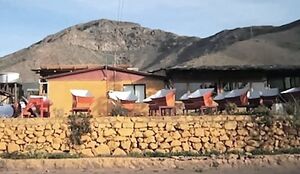
The Delicias del Sol restaurant in Villaseca, Chile
- Solar restaurant in Chile has produced profits - The Delicias del Sol restaurant, known for serving excellent food, has become a tourist destination for the village of Villaseca, Chile. Begun in 2000 with an initial seating capacity of sixteen, the solar restaurant now seats 120. The dry central valley area receives over 300 days of sunshine a year, and like similar areas, traditional fuel sources are becoming ever more scarce and expensive. The tourists enjoy viewing the solar kitchen at work. Visit the Delicias del Sol restaurant.
News and Recent Developments
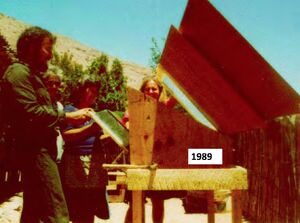
Solar cookers being developed in 1989 in Chile. - Pedro Serrano
- August 2014: Pedro Serrano, a longtime advocate for environmental conservation and justice, has just released the first installment of the technical, social, and political issues contributing to the history of solar cooking in Chile. Read the report: Solar Cookers in Chile: Technical, Political and Socio-cultural Issues - Pedro Serrano
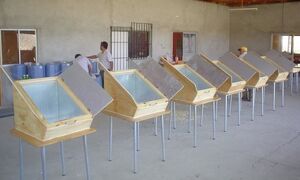
Recently constructed solar box cookers in Ovalle, Chile.
- January 2014: New solar cookers ready for distribution in Chile - Guai Bao, traveling in Chile, sent along this photo of newly constructed solar box cookers at a manufacturing facility in Ovalle. The cookers are well thought out. They are sturdy with insulated inner walls, and an internal high-back reflector to catch late day sun. The front wall is low and slightly tipped forward to avoid blocking any sunlight. The external side reflectors appear to be able swing closed and protect the glass surface. They look ready to start cooking sitting on the small tables, which provides a convenient work height for users. The cooker construction is being supervised by Ruddy Viscarra. See more assembly photos on facebook.
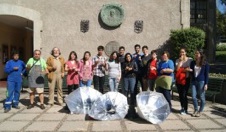
Technical University Federico Santa Maria students with Celestino Ruivo and Pedro Serrano
- October 2013: Celestino Ruivo, Doctor of the University of Coimbra 's academic and University of Algarve, Portugal, visited the Technical University Federico Santa Maria invited by the Academic Department of Architecture, Pedro Serrano. Both belong to international solar cooking organizations. Dr. Ruvio has been developing new lightweight and portable solar cookers, and spent time with students to discuss innovation. Later they traveled to Villaseca to visit Delicias del Sol, the popular local solar restaurant. More information... (Spanish)
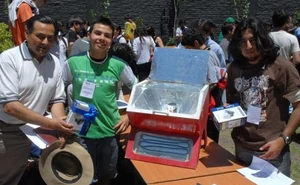
Carlos patricio Eyquem (on right), with his partner Javier, won first place in Chile's national competition for solar oven design.
- March 2013: Solar oven design contest winners - Carlos patricio Eyquem, with his partner Javier, won first place in Chile's national competition for solar oven design. Their solar box cooker design also incorporates some convective and conductive heat transfer concepts. There is a small array of oil-filled copper tubing in front of the cooker which becomes hot, and through convection, transfers the heat to the bottom of the cooking pot inside the cooking chamber. The copper tubing becomes hot as well, and transfers additional heat to the cook pot through direct conduction. Carlos has included some instructions on how to make their design. Read more...
- December 2012: The Delicias del Sol restaurant, known for serving excellent food, has become a tourist destination for the village of Villaseca, Chile. Begun in 2000 with an initial seating capacity of sixteen, the solar restaurant now seats 120. The dry central valley area receives over 300 days of sunshine a year, and like similar areas, traditional fuel sources are becoming ever more scarce and expensive. The tourists enjoy viewing the solar kitchen at work. Read more...
Restaurant's Ovens Powered by the Sun
The Delicias del Sol restaurant has become a tourist destination for the village of Villaseca, Chile in 2012.
- October 2011: The borough of Combarbalá, located in northern Chile, is soon to be named Chile’s first “solar neighborhood”. The households will use solar panels to heat 16 gallons of water at 113 °F, which will allow savings up to 80 percent on the Chile’s notoriously high gas bills. To take advantage of the system, each house was built with an orientation towards the north to get the most sunlight possible. In addition, families were trained in energy saving and solar cooking and heating. Read more...
- April 2011: Restaurant Ayllu in San Pedro de Atacama has begun using solar cookers to prepare food for their patrons. Guests are welcome to see the solar cookers in action. Watch a video of a recent afternoon's activity.
- August 2009: Responding to the urgent need to introduce alternative fuels, the United Nations Development Program, the Global Environment Facility and the European Union partnered with the Chilean government and communities in northern Chile to bring an eco-friendly and creative solution – using energy from the sun. The project sparked entrepreneurship, and some apprentices have become masters, selling ovens, stoves or teaching the techniques to other communities in other regions. In a previous, similar initiative in Chile’s Atacama Desert, local people built special stoves that look like mirrored parabolic dish antennas. Miguel Perez, one of the beneficiaries, now teaches the solar stove-building techniques to people in neighbouring communities. Click here for the full story.
- July 2009: A group of 25 neighbors, under the guidance of solar cooker specialist Aldo Bravo, have begun to build solar cookers out of cardboard and aluminum foil. Their goal is to create an environmentally friendly and econonically feasible method of cooking. For the full article on this workshop, see Vecinos construyen cocinas solares con taller impartido por Codelco - Loactual: Comunicación Digital
The History of Solar Cooking in Chile
The long thin nation of Chile, stretching along the western flank of the Andes for close to half of the continent, has lively and extensive solar cooking programs in this part of the world. Considerable collaboration between a number of university faculty members, government units, and voluntary organizations has produced a situation which provided enormous publicity for the use of solar cookers. Even though the technology cannot be used in all parts of Chile for all months of the year, a number of projects have been carried out successfully and use is widespread in areas where solar cooking is appropriate.
Faculty members of the Institute of Nutrition and Food Technology, University of Chile, were instrumental in starting early programs in various regions of the country, testing devices and project methods in arid and semi-arid regions where fuel had become extremely scarce. In early stages, a "national contest" was held to encourage innovation in design and to create widespread interest in the potential. Twenty-two designs were submitted to the competition, clearly reflecting strong interest. Eight of them proved to function satisfactorily and were later used in the demonstrations. Next, an "encounter" was held, focusing on how to make cookers available economically and how to adapt them to the specific needs of households. A project was then developed in a rural municipality town, Lampa, north of Santiago (central in the country), employing a population of 72 families as interviewees to explore issues of fuel usage and expense, household size and food preferences, cooking patterns, etc. A small number of cookers were made available for use of selected families as "experimenters". Considerable interest was generated, other community meetings were held, and ultimately the community decided to build cookers themselves. This experiment served as the basis for projects in different areas. A portion of this work was accomplished in connection with a UNESCO project focused on use and conservation of hydrological resources in Latin America and the Caribbean. Representatives of this university unit have also prepared an excellent solar cookbook for use in projects in Spanish-speaking countries.
A number of other institutions have collaborated in solar promotion in Chile, including the Universidad Technica, School of Architecture, where a prominent promoter, Pedro Serrano, is affiliated. The best known project in Chile is located in Villaseca, also north of Santiago. In this community, virtually all residents cook with solar power. The area is ideally suited, being blessed with 310 days of sunshine in a year and plagued by dramatic fuel scarcity. Perhaps the best known part of the work in Villaseca (and certainly the best publicized) is the open-air solar restaurant using ten large reflecting ovens and providing employment for members of 26 families. It serves meals to around 60 people a day and must turn down 40 others until it can increase its capacity. It is a frequent stop for tourist groups from many nations. The owners also use homegrown organic vegetables and fruits and are reputed to serve the best food in Chile.
Many stories are associated with the Villaseca experiment, including one about the local safety inspector who insisted they needed a chimney for smoke to pass through. But for the most part, the work garners praise and its proprietors are kept busy responding to questions from other villages that would like to emulate the project. Serrano estimates that there are around 300,000 potential users of solar ovens in Chile. Villaseca women have also been lending a helping hand to women in neighboring Paraguay who are interested in learning more about solar cooking.
The experiments in Chile appear to have substantial support from government and other organizational sources. In addition, as long ago as 1992, the German group, Solar Institut Julisch, had demonstrated the use of parabolic cookers with retained heat capacity, an experiment later repeated in India, Egypt and elsewhere. Chileans have thus been exposed to a range of types of cookers, in the search for designs powerful enough for their climate.
[Information for this section was taken originally from State of the Art of Solar Cooking by Dr. Barbara Knudson]
- See Article from July 2006: 20 Years of Solar Cookers In Chile - Pedro Serrano
Climate, Culture, and Special Considerations
Resources
Blogs
Reports
- August 2014: Solar Cookers in Chile: Technical, Political and Socio-cultural Issues - Pedro Serrano
- Uso de Cocinas Solares y sus Impactos en la Comunidad de Villaseca, Chile - Pedro Serrano
Articles in the media
- September 2010: Eco Camping and Hostel in Puerto Guadal, including solar cooking
- October, 2009: Nine Years Cooking with Pure Sunlight - La Nacion More information about the Villaseca Solar Restaurant...
- September 2009: Construcción de cocinas solares: Equipo USM desarrolla taller en el norte del país - Universidad Santa Maria
- August 2009: Los hornos solares ayudan a Chile a prevenir la deforestación - Programa de las Naciones Unidas para es Desarrollo: Sala de Prensa
- July 2009: Vecinos construyen cocinas solares con taller impartido por Codelco - Loactual: Comunicación Digital
Web pages
Grupo de discusión Facebook
Audio and video
- April 2011
- October 2010
Chile's Solar Restaurant
A visit to Villaseca Solar Restaurant.
- November 2006
Contacts
The entities listed below are either based in Chile, or have established solar cooking projects there:
SCI Associates
- Main article: Solar Cookers International Association




